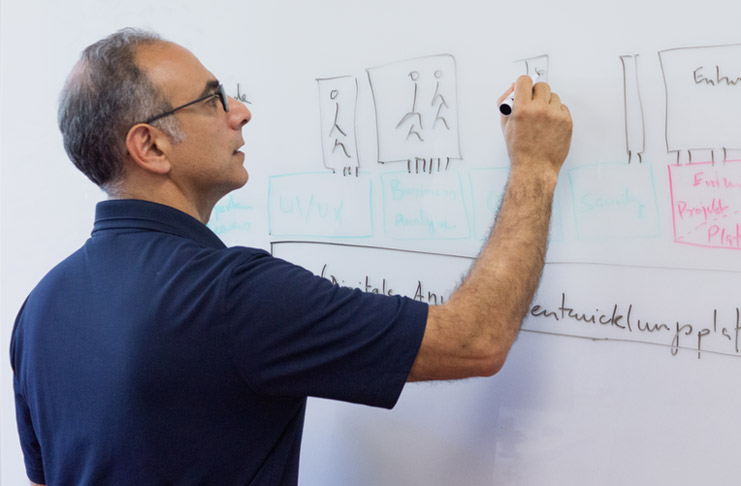Hamarz Mehmanesh, CEO and founder of mgm, discusses with the editors of mgm live the development of the IT industry, current and future challenges that IT project specialists face, and the complexity of business applications.
mgm live: Hamarz, you have been supporting software development projects for over 20 years. What has changed over the years? What current and future challenges does the industry now face?
Hamarz Mehmanesh: For a number of years we have mainly seen two phenomena that influence the industry to an enormous degree. For one, organizing the development process has undergone drastic changes toward agile approaches and methods. For another, IT has become a part of the core strategy of large customers and corporations. Take digitization, for example. IT capabilities decide whether a corporation lives or dies. Competition has long ceased to come only from within the industry; it also comes from Silicon Valley.
IT has become a part of the core strategy of large customers and corporations.
mgm live: When corporations recognize IT as a strategic factor what consequences does that have for their IT departments?
Hamarz Mehmanesh: Corporations have realized how important it is to set up development departments of their own and to be in a position themselves to see in-house developments through to production. It was much the same in the 90s and early 2000s when software projects were not necessarily outsourced. Corporations ran gigantic in-house software projects but had totally unrealistic ideas. Models and diagrams were generated for a year or two and then sent “down” to Development. Millions were wasted in this way until corporations focused on first getting to know and optimizing business processes. IT administrative structures were developed, but little by way of genuine development competence. Those were the golden days of outsourcing. It is different now, with corporations bringing the actual engineering knowhow back in-house.
mgm live: Does that enable them to create complex software by themselves?
Hamarz Mehmanesh: Yes, in some cases it does, and that is due largely to the development method. In the course of the move toward agility, modern corporate IT is using the same methods as soundly based IT project specialists. They have small teams with a high level of direct responsibility. Specialist and technical experts collaborate in a team with short decision-making paths. There are no more three-year plans; just an iterative approach. A younger generation is now assuming responsibility and has no qualms about creating large applications. The new generation of executives has practical experience of project management.
mgm live: What does that mean for IT project specialists like mgm?
Hamarz Mehmanesh: Having good references, knowhow acquired over the years, and outstanding engineers and architects is no longer enough. We constantly ask ourselves what added values we can offer customers other than experience in all aspects of project management. For us that is a challenge and at the same time an incentive to make the software development process more efficient. The aim is clear: we must offer long-term cooperation benefits that surpass previous levels.
Having good references, knowhow acquired over the years, and outstanding engineers and architects is no longer enough.
mgm live: What approaches does mgm rely on to make software development more efficient?
Hamarz Mehmanesh: I always measure our progress along the guidelines that shaped the Industrial Revolution: specialization, automation, division of labor, and innovation. We clearly specialize in creating digital business applications. In automation there is a major focus on project infrastructure and automatic QA, with DevOps as the keyword. Division of labor is exciting because we have developed dedicated teams that also work across projects and have thereby acquired an enormous treasure trove of experience. They include the UI/UX Team with its focus on device-independent business applications and the Web Application Security Team. In addition we have a central quality assurance unit that is there whenever load, performance, scalability, and test automation on a large scale are required. We have our consulting division, which powers change processes and structures and manages projects. What is special about them is that all these teams are well established. Their working methods have been optimized over the years. So our contribution to cooperation is not only experts but also tried and tested organizational structures.
mgm live: Does that mean efficiency is primarily a matter of organization?
Hamarz Mehmanesh: Not only. Innovation is also involved and for us that means innovating the software creation process itself. Relying on model-based development we enable business analysts to define much of the software by means of models, using special tools. That shortens the development process and ensures that the software can be adapted swiftly to changing requirements. All of this we contribute toward cooperation. We provide a platform – a software platform and working methods – and offer customers an opportunity to become part of a community. And we are totally transparent about what is already available and what will still be needed in the future. That is an entirely different basis for embarking on a new project than a newly bought-in team of freelancers starting from scratch.
We provide a platform – a software platform and working methods – and offer customers an opportunity to become part of a community.
mgm live: A current trend in corporate IT is to rely on small, independent teams and microservices. How do you rate this development?
Hamarz Mehmanesh: The trend toward microservice architectures involves the following phenomenon: the developers behind each service can decide which technology they use, what they deploy, and how they deploy it. Componentization, or whatever you call it – division into modules, services, and microservices –, it must be said, is nothing new. What is new is that the separateness and autonomy of services are now taken so far that they can be deployed and managed separately. But that, in my opinion, does not address the core problem with this development. When specialized changes occur, the adjustments required extend to a number of modules. That makes them even more painful than if I had not undertaken this finely granular division and separation. Our method, in contrast, focuses on entirely separating the specific functionalities from the technology by means of domain-specific models. Modern software must simply be able to respond swiftly to changes.
Our method, in contrast, focuses on entirely separating the specific functionalities from the technology by means of domain-specific models.
mgm live: So domain specifics are the sticking point of business software, are they?
Hamarz Mehmanesh: Yes, you could say that. Business domains are extremely complex. Knowledge is distributed among many people. There are few if any standards. Each customer has his own terminology and logic. Business undergoes fast and frequent changes, be they due to new payment methods, new sales or to collaborative approaches. Domain specifics are normally covered at many levels and in many forms of representation. Our way provides for a single representation that is clearly separated from the technology and can be adapted from the domain side – even without developers.
mgm live: In view of all these endeavors to develop software more efficiently, does an “Industrial Revolution” still lie ahead for the IT industry?
Hamarz Mehmanesh: IT has for long lived on a lucky cloud with huge areas of scope for development. I believe that the pressure to change will increase. One needs only to look at what is happening in other industries. When an engineering company markets a new product it will need to halve its production costs in the years ahead to survive. IT has not yet had to face such necessities. But they will come. That is why we have for years invested not just in project management pure and simple; we invest consistently in research and development and in cross-project expert teams. The bottom line is that we as a service provider must be a step ahead. That also makes us attractive for applicants and experts in the market. We do pioneering work in many areas around the development process. That is why we see ourselves as not just project managers for our customers but as long-term partners in the successful digitization of their business.








